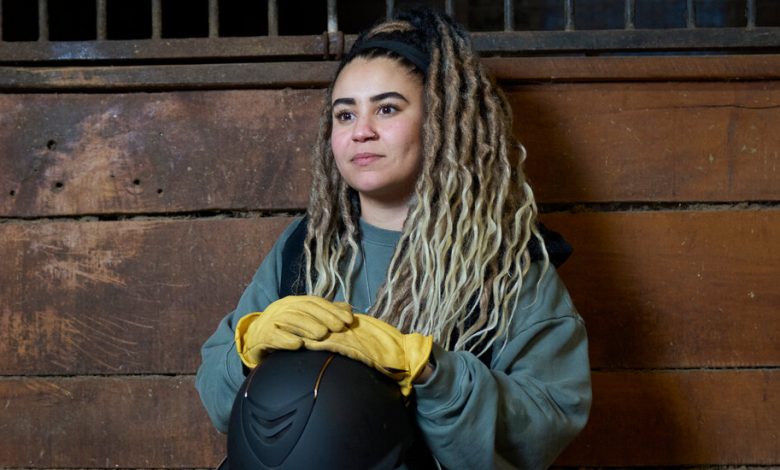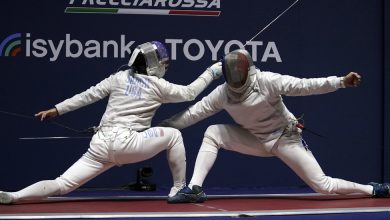Black Equestrians Want to Be Safe. But They Can’t Find Helmets.

Chanel Robbins has been riding horses most of her life, ever since her grandmother traded a cow from their family’s farm in Ontario for a pony when she was 7.
Galloping through the fields on her pony, Star, offered an escape from thoughts that weighed on her — that she didn’t have a relationship with her biological parents, for instance, or that she was the only Black girl in the neighborhood, aside from her sister.
About eight years ago, she reconnected with her father, a native of Jamaica. As the two grew closer, Ms. Robbins decided to style her hair in dreadlocks, like her dad. But there was a problem: Her riding helmet no longer fit, and she couldn’t find one that did.
“I finally freaking feel like myself, and now society is asking me to change,” Ms. Robbins, 27, of Alliston, Ontario, said as she choked back tears. “I just want to be able to ride.”
Black equestrians have long felt virtually invisible in a sport that remains overwhelmingly white. For those with natural hair, which for many is a declaration of pride and Black identity, finding a helmet that fits properly can be nearly impossible, creating yet another barrier to full inclusion. Some are now lobbying for change, mindful that horseback riding is among the leading causes of sports-related traumatic brain injury. The helmet companies say there isn’t a simple fix.

Ms. Robbins, 27, changed her hair after reconnecting with her biological father, a native of Jamaica who wears his hair in dreadlocks. “I finally freaking feel like myself and now society is asking me to change,” she said.Credit…May Truong for The New York Times
Among those raising awareness on social media is Caitlin Gooch, who grew up riding horses on her family’s farm in Wendell, N.C. For Ms. Gooch, 30, who wears her hair in locs that fall to her mid-back, safety has been of paramount concern because her father injured his neck in a fall from a horse when he was not wearing a helmet. When she has her hair redone, about once every two months, she brings her riding helmet with her to ensure it will still fit.
Around 2015, when she started teaching riding lessons, she found herself having to tell children they couldn’t ride if there was no helmet that properly fit them. In 2021, she started a hashtag, #saddleuphelmeton, to call attention to the problem.
Trying to stuff a head into a helmet that doesn’t fit presents a safety risk, not unlike “trying to fit a baby into a car seat that doesn’t fit them,” Ms. Gooch said. “The helmet just would not do what it was supposed to do.”
‘People Are Different, Hair Is Different’
Several prominent equestrian helmet manufacturers contacted by The New York Times said they were not aware that many Black riders struggled with helmet fit. Others said they recognized that it was an issue and were working to address it, while cautioning that bringing a new helmet to market is a costly undertaking that can take years.
The Times spoke with nearly a dozen Black riders, several of whom described searches for properly fitting helmets that dragged on for months or even years. Some said they had been turned away from equestrian stores by employees who said they couldn’t help them. A few said they had manipulated helmets by stuffing them or cutting the lining.




Clockwise from top left: Caitlin Gooch on her farm in Wendell, N.C.; a mentor with CREW Urban Youth Equestrians works with one of the group’s horses in Hastings, Minn.; Aderes James, 10, who follows a two-hour routine to get her Dutch braids to fit under her riding helmet; and Isabella Tillman at a hunter competition. Credit…Caitlin Gooch, CREW Urban Youth Equestrians, Rena Baxter James, Isabella Tillman.
Isabella Tillman, who wears her hair in natural, buoyant curls in the summer and straightens it in the winter, is horrified when she thinks about the helmets she has used in 20 years of riding.
One sat atop her head like a traffic cone, she said. Another was so small it gave her headaches. And one was so big, she had to stuff it with maxi pads.
“There is nothing out there in the industry that is addressing these needs,” said Ms. Tillman, 29, of Detroit, who is working toward becoming an equine veterinarian. “People are different, hair is different and heads are different.”
‘A Big Issue for a Small Amount of People’
It is not clear exactly how many riders are affected. The United States Equestrian Federation, one of the major governing bodies overseeing competitive horse sports, does not require its 447,000 members to disclose their race, and only about half do so. Of those, nearly 92 percent are white, with Black riders making up only 0.5 percent.
Helmet inclusivity is important, Black equestrians said, because it could mean the difference between life and death. A 2019 study published in the journal Sports Medicine found that 70 percent of reported equestrian falls caused a head injury. Wearing a properly fitting helmet helped prevent more serious injuries, such as skull fractures, the study found.
Dr. Thomas A. Connor, an engineer who has researched equestrian helmet safety and was a co-author of the study, said that the difficulty many Black riders had in finding helmets was “a big issue for a small amount of people.”
“There’s a real need to address it and absolutely zero desire to do it,” he said. “If you owned a helmet company you could decide to solve this problem tomorrow.”
Companies that make equipment used in other sports have taken steps to adapt helmets and other gear to accommodate Black athletes’ natural hair.
Riddell, one of the leading manufacturers of helmets used by N.F.L. players, has developed a helmet with customized “precision-fit” padding, ensuring that any hairstyle will fit. And last year, the International Swimming Federation approved the Soul Cap, which accommodates thicker, curlier hair, for use in major competitions.
No Quick Fix
Equestrian helmet manufacturers say it is not as simple for them because the safety standards and certification-testing requirements are vastly different from other sports.
Laura Qusen, chief operating officer at Tipperary Equestrian, said she was not aware of the challenges Black riders faced in finding helmets until Ms. Robbins, the rider from Ontario, wrote to the company in January.
In an interview, Ms. Qusen acknowledged that it was “clearly not a one-person problem” and committed to investigating it further. But she worried that developing a new helmet would require new safety standards, potentially driving up the cost of a product for which there might not be much demand.
“If it’s truly a manufacturing problem, anything is possible, but we’re talking years of development,” Ms. Qusen said.
The exchange with Ms. Qusen left Ms. Robbins in tears. She wondered if it was time to find a new sport, one that would make her feel like she mattered.
Charles Owen, a popular helmet company that sponsors Olympic athletes, is working on “several solutions” to help customers whose hairstyles often change and expects to introduce them sometime this year, Alex Burek, the company’s marketing director, said. She declined to comment further.
But the riders’ concerns have yet to reach Back on Track, a market leader that makes equestrian products, including helmets in a variety of shapes and sizes, with removable liners. In an interview, James Ruder, the chief executive, said the company’s helmets can accommodate most riders. He added that he had “never once heard” about a Black rider struggling with helmet fit.
“If you have an ‘oddity’ — and I don’t mean to be disrespectful to the people who have weird hairstyles — but if you have a hairstyle that impacts the functionality of the helmet, you might just have to change it,” Mr. Ruder said.
In a follow-up interview, Mr. Ruder stood by his view that riders need to be aware that their hairstyle choices can affect helmet safety, and added that he intended no offense with his comments. “I’m bald, and some people find that weird,” he said. “It’s all relative.”
‘This Sport Isn’t Designed for Us.’
Black riders say the manufacturers’ responses demonstrate what they’re up against.
“Sports were only developed for white people and they continue to keep white people protected,” Ms. Robbins said. “People need to realize diversity and inclusion belongs anywhere, especially in sports.”
A new helmet can’t come fast enough for Aderes James, 10, of Bethesda, Md.
On competition mornings, the other girls on her hunter show team tuck their hair into their helmets to create a clean look that will impress the judges. Aderes follows a two-hour routine the night before with conditioners and detangler spray. Her mother then plaits her thick hair into two Dutch braids that fit under her helmet for the show ring.
“It makes me feel a little left out,” Aderes said. “But it’s the cost of healthy, curly hair.”
Her mother, Rena Baxter James, said she and her husband made it a priority for Aderes to embrace her natural hair, but it often felt like an obstacle.
“You’re asking people to change the texture of their hair instead of learning how to offer a proper fit,” she said, adding that “mostly everything in this sport isn’t designed for us.”
‘Like Reopening a Wound Every Time’
Chauntel Smith and Jenny Benton have become quite adept at manipulating young riders’ heads into helmets.
The two co-founded a Minnesota nonprofit, CREW Urban Youth Equestrians, in 2021 to provide opportunities for Black youth and other children of color to learn about horses while developing tools to manage their emotions. Getting a helmet to work is often a time-consuming task that can take away from saddle time, they said.
“It’s like reopening a wound every time,” Ms. Smith, who is Black, said. “And it’s so counterproductive to the purpose of why they are out here at the barn, to have a safe space.”
Ms. Tillman, the aspiring equine veterinarian from Detroit, eventually replaced the helmet she’d stuffed with maxi pads with a new one, cutting pieces of the lining out until it nestled comfortably on her head. But now she worries.
“It makes me feel less comfortable about the safety of a helmet that I’m just doing this myself,” she said. “It certainly doesn’t make me feel included or that people with hair textures like mine are important.”




